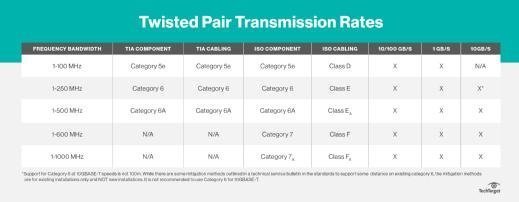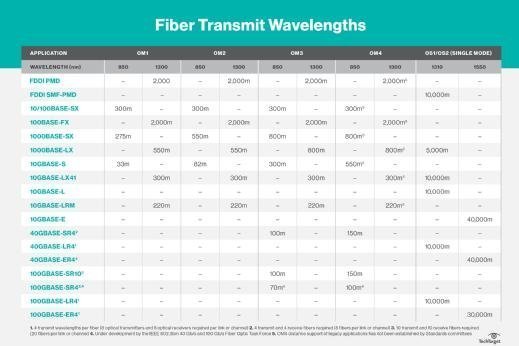
Kadmy - Fotolia
Comparing cable types: Fiber vs. copper twisted pair
What's the difference in fiber vs. copper cables? Key differences include cost, speed and more when it comes to fiber optic and copper twisted-pair cabling options.
Enterprise data centers are underpinned by miles of cable, connecting the thousands of networking devices businesses rely on to support their operation. Those cables include fiber optic cable and copper twisted pair. And each of these cables is engineered to meet specific demands. Let's compare fiber vs. copper and take a close look at each type of cable, then discuss where it might be used in today's complex networks.
Enterprises have several options to support their wired and wireless network transmissions -- bear in mind, all wireless access points have a wired component. Standards vary, depending upon the type of connectivity to be used. For Ethernet, the most widely used protocol, the Ethernet Alliance publishes a roadmap every year that explains new and emerging specifications. The Institute of Electrical and Electronics Engineers Inc. maintains a list of other cabling specifications, as does Standards Informant, a blog published by cable manufacturer Siemon Co.
In addition, the Fibre Channel Industry Association publishes its own list of standards governing the use of that storage networking protocol. And other industry associations publish standards for their specialty applications. For the purpose of this primer, however, we will address Ethernet only, as it is the most predominant protocol used today for LAN, Wi-Fi uplinks and data centers.
Fiber vs. copper: Pros and cons
There are pros and cons to both fiber and copper distribution methods. Fiber is, generally, the more accepted method, and it is used for backbone and long-haul applications. Copper remains dominant for server-to-switch and desktop-to-switch connections. That's because copper ports are less expensive and they can auto-negotiate -- that is, they can support multiple speeds out of the same port. Another benefit of copper is the ability to supply DC power over the data cabling, thus removing the need to run additional electrical services to a variety of end devices. If evaluating fiber vs. copper, consider the media -- copper or fiber -- the cost of the ports at both ends, length of time the application will be supported, maintenance costs and so on. Examining per-port and power costs is not as revealing as examining the total cost for your communication requirements.
When deciding where and when to use fiber vs. copper -- or when deciding whether to use both -- one must also think about the distances that need to be supported and the transmission speeds required. Fiber and copper vary in range for what can be supported and to what distance.
Twisted-pair copper cable
Copper cabling comes in both shielded and unshielded twisted pair (UTP) varieties. Shielded is classified as F/UTP, or foil around UTP, and S/FTP, or shielded foiled twisted pairs. All of the categories shown above support PoE (Power over Ethernet), PoE+ and the newer PoE++/UPoE under development. The higher the category, the better its transmission performance; furthermore, shielded systems will yield better heat dissipation in powered applications.
Structured copper cabling channels, such as BASE-T, are designed to support 100 meters -- with the exception noted below. There are length deratings in both Telecommunications Industry Association and International Standards Organization (ISO) for cabling run in high-heat areas. The shielded derating factor is roughly half that of unshielded systems in those high-heat areas.

With the exception of Category 7 and 7A, all of the copper interfaces above use RJ-45 connectors. Category 7 and 7A connectors are specified by ISO/IEC standards, which are followed worldwide.
There are some other copper cables on the market that are application-specific, but not supported by the standards; therefore, they're not covered here.
Fiber optic cable
Fiber transmission rates depend on distance, diameter of the fiber and the light source used to move the light over the fiber. Single-mode fiber is designed for the longest-haul applications, while multimode fiber is generally used for shorter uplink, server-to-switch and backbone applications. Distances supported for the published standards are listed below.

Fiber distances are maximum lengths and may decrease based on link-loss budgets. A fiber link-loss budget is a combination of total fiber distance and number of connectors in the channel. The greater the number of connectors in the channel, the shorter the distance supported. Newer low-loss connectors increase the number of connections that can be used in a channel and still support the application. Consult your fiber manufacturer for details. It is also worth noting, in some cases, the active electronics and fiber combinations may support distances in excess of what is in the chart above due to advances in active electronics. The distances shown are based on the published standards and not the application capabilities of some electronics.
All standards call for the use of an LC connector in two-strand fiber connections; for multistrand parallel applications beyond 10 Gbps -- 40GBASE, 100GBASE and so on -- the acceptable connector is a MPO/MTP, or multifiber push-on/mechanical transfer push-on, with the difference being the MTP has stainless-steel alignment pins.
When making crucial cabling decisions, it's important to consider the differences of fiber vs. copper and to carefully consider which -- fiber optic or twisted-pair copper -- will work best, and where, in your network.







